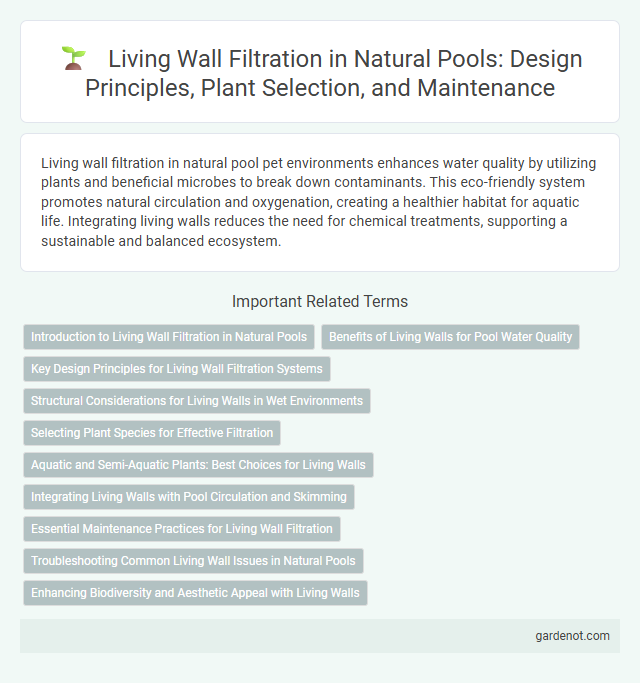Living wall filtration in natural pool pet environments enhances water quality by utilizing plants and beneficial microbes to break down contaminants. This eco-friendly system promotes natural circulation and oxygenation, creating a healthier habitat for aquatic life. Integrating living walls reduces the need for chemical treatments, supporting a sustainable and balanced ecosystem.
Introduction to Living Wall Filtration in Natural Pools
Living wall filtration in natural pools integrates vertical plant systems to enhance water purification by harnessing biofiltration and phytoremediation processes. These living walls support microbial communities that break down organic contaminants while plants absorb nutrients, reducing algae growth and improving water clarity. This sustainable filtration method complements traditional biological filters, promoting a balanced aquatic ecosystem and reducing chemical use.
Benefits of Living Walls for Pool Water Quality
Living wall filtration enhances natural pool water quality by using plants and beneficial microorganisms to break down organic matter and filter out pollutants, reducing the need for chemical treatments. The root systems in living walls increase oxygenation and promote biofiltration, creating a balanced ecosystem that supports clear, healthy water. These bioactive vertical gardens also improve pool aesthetics while providing natural habitat for beneficial insects that contribute to water purification.
Key Design Principles for Living Wall Filtration Systems
Living wall filtration systems for natural pools rely on biofiltration principles where plants and microorganisms collaboratively purify water by absorbing nutrients and breaking down pollutants. Key design principles include selecting plant species with high nutrient uptake capacity, ensuring sufficient water flow through the root zone for optimal microbial activity, and incorporating a multi-layer substrate to support diverse microbial habitats. Integrating these elements enhances water clarity and maintains ecological balance within the natural pool environment.
Structural Considerations for Living Walls in Wet Environments
Living wall filtration systems in natural pools require robust structural design to withstand constant moisture and weight of saturated growing media. Materials such as corrosion-resistant steel frames and waterproof membrane backings ensure durability and prevent water infiltration into supporting structures. Proper anchoring and drainage layers are essential to maintain stability and promote healthy plant growth while preventing waterlogging and structural damage.
Selecting Plant Species for Effective Filtration
Selecting diverse aquatic and marginal plant species such as reeds, cattails, and water irises enhances living wall filtration by maximizing nutrient absorption and pollutant removal efficiency in natural pools. Plants with extensive root systems like Phragmites australis facilitate microbial activity essential for breaking down organic contaminants. Incorporating native, fast-growing species improves resilience and aids in maintaining clear, oxygen-rich water with minimal maintenance.
Aquatic and Semi-Aquatic Plants: Best Choices for Living Walls
Aquatic and semi-aquatic plants such as water iris, cattails, and marsh marigolds are ideal for living wall filtration in natural pools, as they effectively absorb nutrients and filter pollutants. These plants enhance water quality by promoting beneficial microbial activity and preventing algae growth through natural oxygenation. Incorporating diverse species with varying root depths maximizes filtration efficiency and supports a balanced aquatic ecosystem.
Integrating Living Walls with Pool Circulation and Skimming
Living wall filtration enhances natural pool ecosystems by integrating vegetation with pool circulation and skimming systems to improve water quality through biofiltration and nutrient uptake. This hybrid approach leverages plant roots and microbial communities to break down contaminants while the skimming mechanism removes surface debris, maintaining clear water and balanced ecosystems. Efficient design ensures water flows seamlessly from the pool through living wall substrates, optimizing filtration and reducing chemical usage.
Essential Maintenance Practices for Living Wall Filtration
Living wall filtration in natural pools requires regular pruning and removal of dead or diseased plant material to maintain optimal water purification. Monitoring nutrient levels and irrigating appropriately ensures a balanced ecosystem, preventing algae growth and promoting healthy microbial activity. Periodic inspection of the filtration system prevents blockages and supports efficient water circulation, enhancing the pool's overall water quality.
Troubleshooting Common Living Wall Issues in Natural Pools
Living wall filtration in natural pools may encounter issues like clogged roots, algae buildup, and uneven water flow, which can disrupt filtration efficiency. Regular inspection and maintenance, including gentle root pruning, cleaning of filter media, and ensuring balanced water circulation, help restore optimal function. Monitoring plant health and adjusting nutrient levels also prevent common problems such as root rot and stagnation.
Enhancing Biodiversity and Aesthetic Appeal with Living Walls
Living wall filtration systems in natural pools enhance biodiversity by creating habitats for beneficial microorganisms and plants that improve water quality. These vertical gardens support diverse flora and fauna, promoting ecological balance and natural purification processes. Their lush, green appearance also elevates the aesthetic appeal, seamlessly integrating the pool into its natural surroundings.
Living wall filtration Infographic

 gardenot.com
gardenot.com